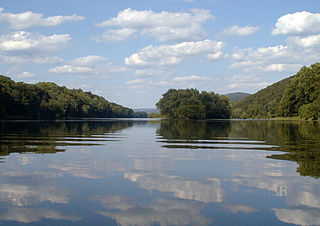Where Does Bronxville’s Water Come From?

By Ellen Edwards
Apr. 11, 2018: We drink it and bathe in it, wash with it and waste it. And, like many of you, I had little idea where it comes from.
I’ve since learned that our water comes from the same complex system that provides water to New York City. Bronxville’s water originates 100 miles northwest in the watersheds of the Catskill Mountains and Delaware River.
Surface water collected from more than a million acres of land flows into one of several “collecting” reservoirs, then through a series of tunnels and two massive aqueducts, the Catskill Aqueduct, considered an engineering marvel when it was completed in 1900, and the Delaware Aqueduct, finished in the mid-1940s and so large that a two-man submarine was originally used to inspect it for leaks. A third aqueduct, the Croton, collects water from northern Westchester and Putnam counties and supplies 10% of New York City’s water but none of Bronxville’s.
By gravity alone, our water eventually makes its way 1100 feet below the Hudson River and over to the Kensico Reservoir, three miles north of White Plains. Here, for the first time, the water is tested and treated. Renowned for its high quality, New York City is one of only five municipalities nationwide that is not required to filter its water.
Nevertheless, Bronxville’s water can arrive at the Kensico Reservoir contaminated by agricultural and residential run-off, pesticides, and nitrates. It is treated with chlorine, which protects against microbiological contamination; fluoride, which helps prevent tooth decay; zinc metaphosphate, which reduces corrosion of metal piping (which might leach lead); and caustic soda, which reduces acidity.
Downstream, a billion gallons of water each day pass through Westchester County’s state-of-the-art Catskill-Delaware Water Ultraviolet Disinfection Facility, the largest UV treatment facility in the world. Water treated with chlorine often still contains harmful organic compounds such as Cryptosporidium and Giardia. Since the 1990s, and in particular since this $1.5 billion facility opened in 2012, UV radiation treatment has been used to further purify your water.
An increasing concern is turbidity—the fine particles of clay and silt that cloud the water, especially after heavy rains and high winds. Such brown water can interfere with water treatment. Increasingly, too, climate change is affecting rain patterns, the health of forests, and water temperature—all of which impact the quantity and quality of your water. Thanks to our farsighted forefathers, the New York City water supply’s interconnected three-tiered system gives it the flexibility to adjust to changing conditions. When drought affects one region, water flow can be switched to draw on other areas. The system relies entirely on surface water from rainfall; it does not draw from underground aquifers.
Of course, testing is done for many additional contaminants, but it’s worth noting that tens of thousands of chemicals used in manufacturing processes are not required by law to be tested for in water, nor have acceptable, safe limits for them been set.
After our water has passed all its tests, it continues south to several pumping stations. Once the water enters the town limits, it’s managed by the private company SUEZ, which owns and maintains water pipes within the town, further tests and treats the water, initiates programs of conservation, and manages billing. The water is then pumped to your property and taps. SUEZ purchases Bronxville’s water from the New York City system.
According to Deb Rizzi, a spokesperson for SUEZ, 18% of the water that begins upstate is lost to leaks in our aging system--one reason why Westchester residents have high water bills. Regionally, ongoing work is being done to replace pipes and repair leaks. Completing renovation of the massive Delaware Aqueduct by 2020 will allow each of the other two aqueducts to be shut for relatively rapid renovation. Locally, SUEZ is breaking large grids of pipes into smaller territories called district metered areas so they can detect leaks faster. During the summer, lawn watering can double a town’s water use. SUEZ’s ET Program, available on its website, helps customers water more efficiently.
Consider this: New York City uses gravity to supply 95% of its water; only 5% is pumped. It’s almost all downhill from upstate! In fact, the water pressure is so strong that in New York City the water can reach the sixth floor before it needs to be pumped.
Bronxville faces increasing challenges in providing clean, abundant supplies of water. Perhaps we’ll all be inspired to use this precious, limited resource wisely.
Pictured here: Delaware River.
Photo by Wikipedia user MWanner and used under Creative Commons Attribution-Share Alike 3.0 Unported license. Link to photo and license: https://commons.m.wikimedia.org/wiki/File:Delaware_River_DWG_USA.jpg.
Editor's note: Ellen Edwards is a Bronxville resident and a member of the Bronxville Green Committee, which welcomes volunteers.
Editor's note: As a public service, MyhometownBronxville publishes press releases, statements, and articles from local institutions, officeholders, candidates, and individuals. MyhometownBronxville does not fact-check statements therein, and any opinions expressed therein do not necessarily reflect the thinking of its staff.
Government & History Directory
Bronxville is a quaint village (one square mile) located just 16 miles north of midtown Manhattan (roughly 30 minutes on the train) and has a population of approximately 6,500. It is known as a premier community with an excellent public school (K-12) and easy access to Manhattan. Bronxville offers many amenities including an attractive business district, a hospital (Lawrence Hospital), public paddle and tennis courts, fine dining at local restaurants, two private country clubs and a community library.
While the earliest settlers of Bronxville date back to the first half of the 18th century, the history of the modern suburb of Bronxville began in 1890 when William Van Duzer Lawrence purchased a farm and commissioned the architect, William A. Bates, to design a planned community of houses for well-known artists and professionals that became a thriving art colony. This community, now called Lawrence Park, is listed on the National register of Historic Places and many of the homes still have artists’ studios. A neighborhood association within Lawrence Park called “The Hilltop Association” keeps this heritage alive with art shows and other events for neighbors.
Bronxville offers many charming neighborhoods as well as a variety of living options for residents including single family homes, town houses, cooperatives and condominiums. One of the chief benefits of living in “the village” is that your children can attend the Bronxville School.
The Bronxville postal zone (10708, known as “Bronxville PO”) includes the village of Bronxville as well as the Chester Heights section of Eastchester, parts of Tuckahoe and the Lawrence Park West, Cedar Knolls, Armour Villa and Longvale sections of Yonkers. Many of these areas have their own distinct character. For instance, the Armour Villa section has many historic homes and even has its own newsletter called “The Villa Voice” which reports on neighborhood news.
Link to Village of Bronxville One Square Mile Monthly Newsletter
Village of Bronxville Administrative Offices
337-6500
Open 9:00am - 4pm excluding holidays and weekends
Bronxville Police Department
337-0500
Open 24 hours
Bronxville Parking Violations
337-2024
Open 9:00am - 4pm excluding holidays and weekends
Bronxville Fire Deparment
793-6400













